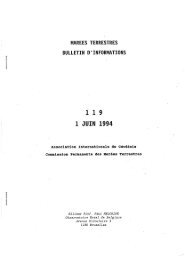marees terrestres bulletin d'informations - Université de la Polynésie ...
marees terrestres bulletin d'informations - Université de la Polynésie ...
marees terrestres bulletin d'informations - Université de la Polynésie ...
Create successful ePaper yourself
Turn your PDF publications into a flip-book with our unique Google optimized e-Paper software.
Assessment of atmospheric reductions for terrestrial gravity<br />
observations<br />
1) 1)<br />
M.Abe, C.Kroner, J.Neumeyer, X.D. Chen 2)<br />
1) Deutsches GeoForschungsZentrum (GFZ), Gravity Field and Gravimetry<br />
2) Institute of Geo<strong>de</strong>sy and Geophysics, Chinese Aca<strong>de</strong>my of Sciences<br />
Abstract<br />
Atmospheric attraction and loading effects account for about 10% of all<br />
observed time-<strong>de</strong>pen<strong>de</strong>nt gravity variations in which the dominant gravity signal<br />
is the ti<strong>de</strong>s of the solid Earth. The impact can be roughly estimated using<br />
barometric pressure from the observation site, but in that case only atmospheric<br />
variations which are corre<strong>la</strong>ted with local barometric pressure changes are taken<br />
into account. If e.g. geodynamic signals are to be investigated, the variations<br />
which are unconsi<strong>de</strong>red have an amplitu<strong>de</strong> of several µGal, therefore they are<br />
<strong>la</strong>rge enough to require consi<strong>de</strong>ration.<br />
In this paper, three different procedures to remove the atmospheric effect are<br />
compared. Numerical results show that the atmospheric reduction using threedimensional<br />
(3D) data from the European Center for Medium-Range Weather<br />
Forecasts (ECMWF) ought to be computed up to 5° around a station. A peak-topeak<br />
amplitu<strong>de</strong> of the differences between a reduction using 3D data and one<br />
using two-dimensional (2D) data from the ECMWF is 0.5 µGal including<br />
seasonal variations with an amplitu<strong>de</strong> of 0.15 µGal, and it has a Root Mean<br />
Square (RMS) value of 0.1 µGal consi<strong>de</strong>ring a time span of 4 years. The<br />
amplitu<strong>de</strong> of reduction based on a regression coefficient/admittance factor differs<br />
from the two physical methods by approximately 3 µGal with a RMS value of 0.4<br />
µGal in the same 4 year-long observation period.<br />
From spectral analyses of the three reductions it emerges that the amplitu<strong>de</strong>s<br />
of the more comprehensive methods are 11-12% smaller than the reduction using<br />
an admittance factor in the spectral range from 0.0 CPD (cycle per day) to 0.18<br />
CPD on average. Investigation of the atmospheric reduction effects on the tidal<br />
analysis indicates that there are visible improvements in the tidal analysis using<br />
the reductions based on the physical approaches compared to the reduction using<br />
an admittance factor but not between the two physical approaches. Concerning<br />
the amplitu<strong>de</strong> factor of the po<strong>la</strong>r motion signal, there is 1.5% difference in the<br />
value of the factor after applying the two physical methods.<br />
The differences between the physical approaches stem from the consi<strong>de</strong>ration of<br />
the air <strong>de</strong>nsity distribution. A peak-to-peak amplitu<strong>de</strong> is about 0.5 µGal when<br />
the attraction effect up to 5° around a station is computed. The omission of<br />
vertical variations in air <strong>de</strong>nsity leads to inaccuracies which should be avoi<strong>de</strong>d,<br />
for instance, in the validation of non-tidal ocean loading effects or studies of<br />
tectonic phenomena.<br />
Keywords: Atmospheric reduction, Time variable gravity



